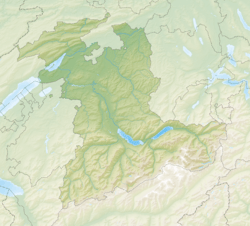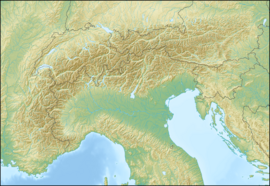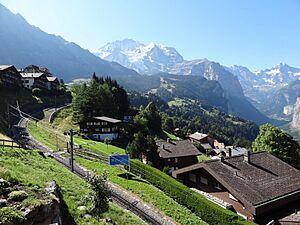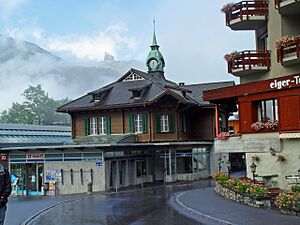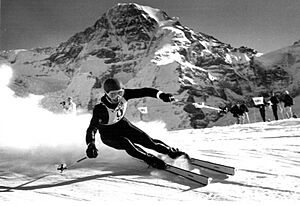Wengen facts for kids
Quick facts for kids
Wengen
|
||
|---|---|---|
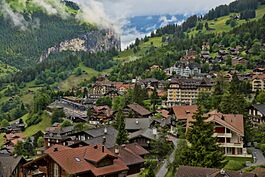
Wengen in June 2012
|
||
|
||
| Country | Switzerland | |
| Canton | Bern | |
| District | Interlaken-Oberhasli | |
| Municipality | Lauterbrunnen | |
| Area | ||
| • Total | 36.4 km2 (14.1 sq mi) | |
| Elevation | 1,274 m (4,180 ft) | |
| Population | ||
| • Total | 1,300 | |
| • Density | 35.7/km2 (92/sq mi) | |
| Postal code |
3823
|
|
Wengen (German pronunciation: [ˈvɛŋən]) is a charming mountain village in central Switzerland. It is located in the canton of Bern at an elevation of 1,274 meters (about 4,180 feet) above sea level. Wengen is part of the beautiful Jungfrauregion.
About 1,300 people live in Wengen all year round. This number grows to 5,000 in summer and 10,000 in winter! Wengen is famous for hosting the classic Lauberhorn ski races every January. These races are part of the FIS Alpine Ski World Cup.
Contents
History of Wengen
Wengen was first mentioned in official papers way back in 1268. No one knows for sure where its name came from.
From Farming to Tourism
At first, Wengen was mostly a farming village in the mountains. But in the early 1800s, people started visiting for its amazing views. Famous writers like Mary Shelley and Percy Bysshe Shelley wrote about the area in their book History of a Six Weeks' Tour. Lord Byron also described the scenery in his play Manfred. These writings helped start the modern tourism industry in Wengen. The composer Felix Mendelssohn also visited in the early 1800s. There is a memorial to him above the village.
Guesthouses and hotels began to open in the mid-1800s. The Launerhaus opened in 1859, offering space for 30 guests. By 1880, the Pension Wengen could host 100 guests.
The Arrival of the Train
The Wengernalpbahn railway was built and opened in the 1890s. This made it much easier for tourists to reach the village. Before the train, visitors had to walk up the steep mountain paths. The railway helped tourism grow even more and started the ski industry in the area.
Skiing Takes Off
In the early 1900s, British tourists started ski clubs nearby. By 1903, Wengen had an Anglican Church. Two years later, Sir Henry Lunn created the Public Schools Alpine Sports Club. Wengen became a popular ski spot for its members. Sir Henry Lunn was a British minister who first visited the area for a church meeting. He learned about winter sports like skiing there.
He returned in 1896 with his son Arnold Lunn. Arnold quickly learned to ski. Both father and son saw a great future in winter sports. Their club was for people who had attended English public schools or older universities. Wengen's Curling Club was also started in 1911.
Birth of Modern Ski Racing
The first ski races were held in the early 1920s. The British downhill championship took place in 1921. The next year, a ski race was held between the universities of Oxford and Cambridge. These were the first races to feature downhill skiing, unlike other Swiss resorts that held Nordic (cross-country) races.
In Wengen, skiers used the train system to get to the slopes. For some years, these trains were the first "ski-lifts" in the area! Arnold Lunn used the natural mountain slopes for the race courses. The downhill event was called the "straight down" because skiers went straight down the mountain. Arnold Lunn also invented the first slalom race in Wengen. In slalom, skiers followed a path through trees, which were later replaced by ski gates. These events are seen as the start of modern ski racing and Alpine skiing.
Wengen During World War II
From August 1944 until the end of World War II, Wengen was used as a special place for Allied prisoners. Most of them were US bomber crews. It was hard for these prisoners to escape because the only way in or out of Wengen was by the cog railway.
Churches in Wengen
Wengen has three churches: a Swiss Protestant church, an English Protestant (Anglican) church, and a Roman Catholic church.
The Swiss church was rebuilt in the 1950s. It offers beautiful views of the Lauterbrunnen Valley.
English churches were built in nearby towns in the 1800s. By 1912, Anglican services were held twice on Sundays in Wengen's Swiss church. People wanted their own building, so a new English church was built. It was officially opened on January 15, 1928. This church, called St Bernard's, is on the road that used to lead to the Männlichen cable car. It has been used for Sunday services for over 90 years. People from many countries, including the British Commonwealth and America, attend services there.
The Roman Catholic church is next to the Falken Hotel. It has a unique onion-shaped dome. Mass is held there on most Sundays during the busy seasons.
Getting Around Wengen
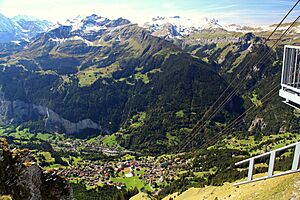
Wengen is one of the few car-free villages in Europe! This means there are generally no roads for cars to enter the village. You might see a few service vehicles, farm vehicles, or electric taxis. This makes Wengen a very peaceful place with less traffic noise. Other resorts are now thinking about becoming car-free too. Across the Lauterbrunnen valley, the village of Mürren is also mostly car-free.
Train Travel
Wengen is served by the Rack railway system called Wengernalpbahn (WAB). You can reach the village directly from Lauterbrunnen. You can also come by train from Grindelwald by changing trains at Kleine Scheidegg.
At Kleine Scheidegg, a mountain pass at the foot of the Eiger, Mönch, and Jungfrau mountains, passengers change trains to go down to Grindelwald. The train service from Lauterbrunnen to Wengen railway station runs all day, from early morning until late at night. This part of the Wengernalpbahn is very busy.
There are about 40 trains between Lauterbrunnen and Wengen every day. During busy times, several trains might run close together to carry everyone. The uphill journey takes about 14 minutes, and the downhill journey takes 17 minutes. Downhill trains take a bit longer because they wait for uphill trains to pass. All trains now use a slightly longer but less steep route.
All goods, like furniture, are brought into Wengen by train from Lauterbrunnen. They are delivered to a special depot under the passenger railway station. Trash from the village is also taken away by train.
Cable Car Access
The cable car called Luftseilbahn Wengen-Männlichen runs during certain seasons. From the cable car and from Männlichen mountain above, you get clear views of Wengen and much of the Lauterbrunnen Valley.
Fun Activities in Wengen
Wengen is famous for hosting the international Lauberhorn ski races. It is also on the route of the Jungfrau Marathon, a challenging mountain running race.
The Lauberhorn Ski Races
The classic ski races have been held in Wengen since 1930. They usually include a downhill race, a slalom race, and a combined event. The Lauberhorn downhill race is one of the most difficult. It is also the longest race in the FIS World Cup circuit and has amazing scenery.
The fastest skiers complete the 4.455-kilometer (about 2.77-mile) run in about 2 and a half minutes. At a spot called Haneggschuss, skiers reach the highest speeds on the circuit, almost 160 kilometers per hour (about 100 mph)!
Wengen Culture
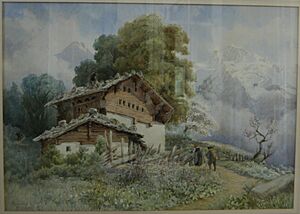
A unique cultural story in Wengen is about the "Pfeifende Lurch." This German name means "whistling amphibian." It is a legendary creature from old myths and tales that is said to live only in Wengen.
See also
 In Spanish: Wengen para niños
In Spanish: Wengen para niños




